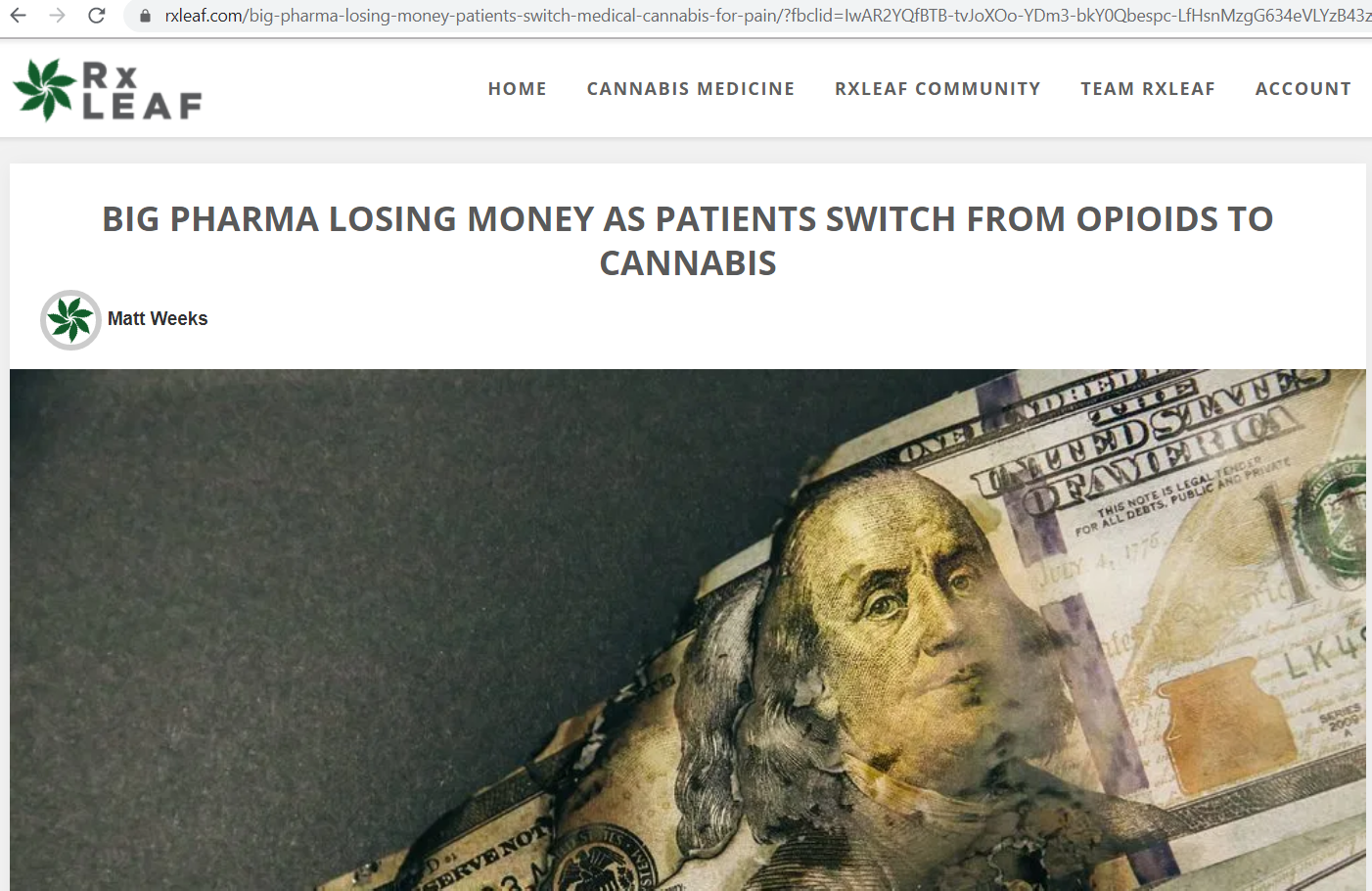Someone linked me this article, which seems to break some big news.

I should have noticed the red flags as soon as I saw that ridiculous logo and huge picture. I mean who starts a blog post off with a large, centred picture of some generic image, right?
When you dig deeper into articles that make bold claims like this though, you often will come across big issues.
This article cited just one medical journal article, which claimed “93% of patients would prefer cannabis to other drugs”, and that “81% of patients reported cannabis alone being better than combining cannabis with opioids” – those high numbers alone instantly screamed “red flags” to me. But upon deeper inspection, there were several more flaws in the study (linked here)
.
First off, a survey study, with no mention of HOW patients were recruited, any randomisation or other such checks or balances or ways of reducing bias destroys the reliability of such a survey completely. This could have (perhaps, it likely was) distributed through a series of pro cannabis pain groups on Facebook for all we know – which would obviously make all results biased.
There are validated pain scales, and better ways of studying the effects of treatments like this, like prospective follow up studies (if not RCTs) of patients who tried cannabis versus those who tried opioids. Though these are harder and more expensive to conduct, if doing a self reported outcome studies – which can still be quite valid (though it’s hard to do this when retrospective) – the authors could have used many techniques to make their findings more solid. They didn’t.
And though the journal this article was published in is peer reviewed, its CiteScore (similar to journal impact factor) is 3.1 – which is quite low – and definitely guilty of publication bias from the quick inspection I did of its most recent titles.
And to boot – I didn’t see much evidence that legalised cannabis is actually responsible for the crippling of opioid sales so much as government crackdowns on opioids. When PROJECTIONS put total displacement of pharmaceutical sales at just $5bn, when the top 15 pharmaeuticals alone generate $560bn in revenues every year, that’s hardly a ‘huge pinch.’ ESPECIALLY when you consider that most applications of medicinal cannabis in patients can and are being patented. Including in pain.
Cannabis is an interesting drug. It DEFINITELY has amazing impacts and potential to help A LOT of people out, likely with less side effects and more efficacy than current treatments for sure! But it also has a cult-like following of #woopedallers who overblow its ability to cure ANYTHING AND EVERYTHING just because it’s #NATURAL and #DANK too.
I did a quick literature review of the matter, going into it thinking, if anything, that medicinal cannabis’s most commonly studied compounds, CBD (cannabidiol, a non psychoactive compound that acts on cannabinoid receptors in the body), and THC (a psychoactive compound that also works on those receptors – a summary of the endocannabinoid system is shown below), would help in chronic pain with minimal side effects – or at least not be harmful. A general view held by many (not just potheads, but doctors as well) is that MJ is not too harmful. But the results were surprising. To summarise, it seems THC, the main compound used to treat chronic pain, seems to make pain more bearable in some, but given its ability to cause mainly psychiatric side effects (including exacerbation of pain, the very thing we’re trying to treat, anxiety, and the activation of psychoses), caution and further research must be done to validate its use, and use cases.
In chronic pain – this great review – reviews are high quality, reliable studies, as they gather data from numerous great sources, goes into the fact that compared to opioids, cannabis based pain treatments actually caused more side effects than opioids per person treated with a number needed to harm as low as FIVE in patients being treated with cognitive issues – https://academic.oup.com/painmedicine/article/10/8/1353/1857926 – while showing no evidence of superiority to opioids either.
This study actually showed cannabis made chronic pain WORSE in most people who got them – AND higher risk of anxiety too! They didn’t even reduce opioid use.
This is in addition to the other, downplayed risks associated with chronic marijuana usage. For instance, smoking cannabis leads to a 76% higher chance of you developing lung cancer. Addiction IS possible, as is tolerance and dependence, and the latter (dependence = the experience of withdrawal when stopping a substance) is experienced by as many as 4.3% of Americans at one point in their life. As many as 3/10 Americans who’ve used marijuana will develop dependence to it, (that number rises to 4/10 of high risk youth), DSM-5 criteria (official psychiatric disorder diagnoses essentially), which added cravings and withdrawal to criteria to determine someone has “cannabis use disorder,” 19% of regular lifetime users will have SEVERE addiction, and 48% of those addicted are not functioning in ANY major role. 7.4% of American youth are abusing cannabis or dependent on it.
Contrary to popular opinion, you do develop withdrawal symptoms when coming off marijuana (dependence) – with patients experiencing symptoms 24-48 hours out of cessation (it can last up to 3 weeks, but usually is bad for a week). Though not as addictive as other drugs, it can indeed induce cravings too (addiction).
Despite claims it’s “100% safe” and that it “never kills anyone due to overdose ” (deaths due to overdose are indeed very hard to induce via cannabis), almost 350,000 people enter EDs every year because of it for various reasons (anxiety/panic to seeking help for addiction – which accounts for over half of these – 177,000 incidences per year).
All reviews and rigorous studies point to the same thing – that cannabis could help in SOME patients with chronic pain (eg this review shows that patients with neurogenic pain could benefit ), but that they DO have harms, and aren’t as efficacious to general populations as people believe. Some suggest that CBD – cannabidiol – one of the major MJ-derived compounds used for medicinal purposes – which has a much lower side effect profile compared to THC (the other major MJ-derived compound studied for medical purposes. It’s the psychoactive component that causes you to get “high”), may improve pain, particularly neuropathic pain, without much in the way of side effects. But THC is the substance most studied in chronic pain thus far, which does have significant side effects.
ALL reviews ask for more rigorous studies on the matter. Studies can’t even agree if increased THC:CBD ratios increase or decrease pain – some suggest that CBD decreases the impact of THC on pain while others say the opposite. Similarly, given up to 10% of people with migraines use it for pain relief, and that there is evidence of it helping out in a subset of these patients (likely mostly those with centrally derived pain), and that we don’t understand the mechanisms and effects of the development of tolerance (if we knew how quick tolerance developed, we could possibly help guide patients in getting maximum benefits for as long as possible while on cannabis) – we NEED to study this potentially wonderful treatment. In a similar trend we see in the literature, we NEED to do more research on this. An interesting way we can do this is through medical apps – indeed, I’m creating one which looks into gauging the efficacy of wellness interventions – and this study done by a company named StainPrint, demonstrated that migraine patients, 50% of the time, get pain relief from medicinal marijuana, but that tolerance develops in time.

Sign up to not just help power medical research, but also to get a chance to win awesome free stuff!
Overall – Medical Marijuana is likely not a viable first line treatment option that we should be prescribing for pain patients in favour of other, less harmful treatments, like cognitive behavioral therapy, treating causes of pain and other neuropathic/antidepressant/medication based treatments. Opioids may help some who don’t develop tolerance better too.
But that isn’t to say opioids, or #bigpharma are amazing either. The opioid epidemic is VERY real and a direct consequence of a few pharmaceuticals going borderlinie LEGALLY rogue (though often going illegal too in its marketing practices) and making wild claims about their drugs being safe and effective. Corrupt and/or negligent doctors WERE very much part of why this got out of hand and has resulted in mass spikes in opioid related deaths in America and other developed nations too. John Oliver explains this REALLY well in this piece – but when a system exists where a single family can PROFIT despite paying billions in fines and breaking criminal law, and killing half a million people in the process… that’s just as bad as snake oils salesmen scamming people and taking lives in their own insidious way too. 1/32 people prescribed 200mg equivalents of opioids DIED during this overly salacious period of prescription https://www.ncbi.nlm.nih.gov/pubmed/26977701. And today, as the government bears down on prescribing these drugs arguably too heavily (denying legitimate patients who NEED these drugs to function), even more are dying to things like suicide.
Lack of phaemaceutical oversight is something I’ll be calling out too – even if it loses me fans – because that too is wrong. There is no reason pharmaceuticals should be allowed to use the tactics they are allowed to. Right now, they spend more than TRIPLE on selling drugs than they do developing new ones. Drug development is skewed too much towards profit these days and productivity/innovation is going down as less and less drugs are in the pipeline – it does need fixing.
I actually wrote a paper on this which never ended up getting published anywhere but did still place me highly in a national essay competition. You can check that out here –> https://nikhilautar.com/improvingbigpharma/
But another downside of opioids is its potential to be addictive, for patients to develop tolerance and/or withdrawal too. This is often overlooked by doctors. I talked about my own experiences of dealing with this recently on my Facebook page – which you can check out by clicking here!
Big Pharma Losing Money As Patients Switch From Opioids To Cannabis



